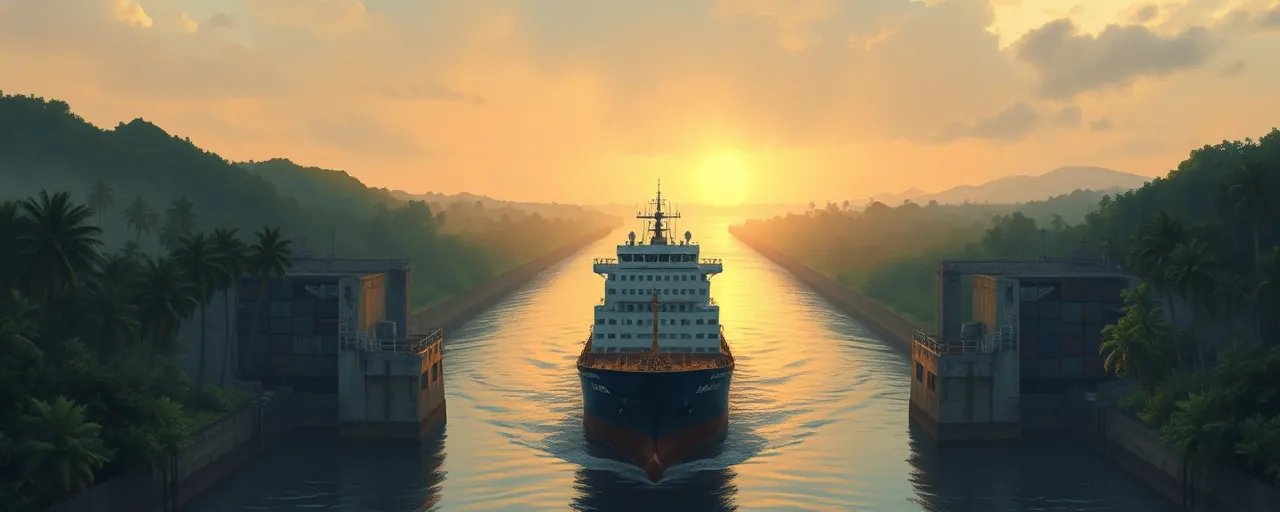A Legacy Under Siege
The Panama Canal isn’t just a waterway; it’s a lifeline. For over a century, this marvel of engineering has fueled prosperity across our hemisphere, linking oceans and slashing shipping routes by nearly 8,000 miles. Teddy Roosevelt knew it when he stepped onto Panamanian soil in 1906, calling it a 'giant feat of the ages.' Today, President Trump echoes that sentiment, recognizing the canal as the beating heart of our shared security and economy. Over 70 percent of its traffic ties directly to U.S. ports, hauling $250 billion in goods yearly. Yet, this artery of global trade faces a creeping threat, one that’s been festering unchecked for too long.
Enter Communist China. Beijing’s tentacles are wrapping around the canal’s critical infrastructure, from ports to logistics hubs, all under the guise of economic partnership. This isn’t about trade; it’s about power. China’s Belt and Road Initiative has already sunk its claws into Latin America, with trade soaring past $450 billion by 2022. Panama, a linchpin in this network, now hosts Chinese firms poised to surveil and manipulate a waterway they didn’t build and don’t rightfully control. The stakes couldn’t be higher: our sovereignty, our prosperity, and our safety hang in the balance.
Beijing’s Playbook Exposed
China’s game plan is as old as it is ruthless. They’ve spent decades buying influence across Latin America, dangling cash for infrastructure projects that leave nations indebted and vulnerable. Panama’s no exception. Chinese companies now hold sway over key canal-adjacent assets, raising the specter of surveillance that could choke our military and commercial lifelines. Defense Secretary Pete Hegseth laid it bare on April 8, 2025, at Vasco Nuñez de Balboa Naval Base: China didn’t dig this canal, doesn’t run it, and won’t be allowed to weaponize it. His words aren’t just rhetoric; they’re a battle cry backed by action.
Look at the evidence. Joint U.S.-Panama military exercises are ramping up, with the USS Normandy patrolling the Caribbean coast and the Coast Guard Cutter Kimball swapping expertise with Panama’s Aeronaval Service. The newly minted Joint Security Cooperation Group Panama is coordinating our forces to lock down this chokepoint. And let’s not forget the $5 million refurbishment of Pier 3, a concrete symbol of America’s resolve. Historical echoes ring loud here; Eisenhower’s highways armed us against Soviet threats. Today’s infrastructure investments arm us against Beijing’s ambitions.
The Pushback Gains Steam
Panama’s leadership gets it. President Mulino’s decision to ditch China’s Belt and Road deal isn’t some diplomatic footnote; it’s a gut punch to Beijing’s dreams of domination. Partnered with the U.S., Panama is doubling down on security, hosting the Panamax exercise in 2026 to drill for every threat from narcotraffickers to cyberattacks. This isn’t about charity; it’s about survival. The canal’s 2016 expansion boosted its capacity by 30 percent, making it a juicier target for adversaries. Our Marine Corps and Navy aircraft buzzing over Panama aren’t just for show; they’re a message that we’re here to stay.
Some naysayers argue we’re overreacting, that China’s investments are just business as usual. They’re dead wrong. Business doesn’t involve potential espionage on a waterway carrying 40 percent of U.S. shipping. Nor does it justify the erosion of sovereignty for Panama, a nation we’ve bled alongside to build this wonder. The data backs this up: nations tangled in China’s debt traps face instability, not progress. Look at Ecuador, hooked on Chinese trade deals yet teetering on dependency. We won’t let Panama fall into that pit.
Faith, Freedom, and Fortress
There’s a deeper thread tying this fight together. Hegseth’s nod to Almighty God blessing Pier 3 wasn’t fluff; it was a reminder of what’s at stake. Religious freedom and national security aren’t separate lanes; they’re intertwined. History proves it: regimes that crush liberty, like China’s, breed chaos and aggression. The U.S. National Security Strategy has long tied religious liberty to stability, a truth borne out by lower terrorism rates in freer nations. Panama’s stand with us isn’t just strategic; it’s a shared belief in sovereignty over subjugation.
This isn’t about bullying our neighbors; it’s about building a fortress of peace through strength. Nearly 100 U.S. military vessels transit the canal each year. Lose that edge, and we’re handing China a loaded gun. Trump’s vision channels Roosevelt’s: secure the canal, secure the hemisphere. The refurbished pier, the joint drills, the cutter slicing through Pacific waters, they all scream one thing: America’s back, and we’re not blinking.
Taking Back What’s Ours
The Panama Canal’s story is ours, forged in sweat and sacrifice by American and Panamanian hands. Workers died to carve this path; we won’t let it slip into foreign grip without a fight. Hegseth’s trip to Panama on April 8, 2025, wasn’t a photo op; it was a line in the sand. With China’s shadow looming, the U.S. and Panama are rewriting the script. Joint exercises, beefed-up training, and infrastructure upgrades signal a partnership roaring back to life. This is what victory looks like when you don’t back down.
The road ahead won’t be easy. Beijing won’t slink away quietly; they’ll push harder, dangling more loans and empty promises. But here’s the deal: we’ve got the will, the muscle, and the moral high ground. Panama’s rejection of China’s playbook, paired with America’s unmatched might, sets the stage for a secure canal and a thriving hemisphere. Roosevelt saw its greatness; Trump’s ensuring its future. Together, we’re not just holding the line; we’re taking back what’s rightfully ours.
